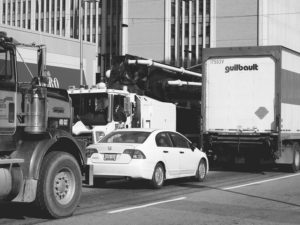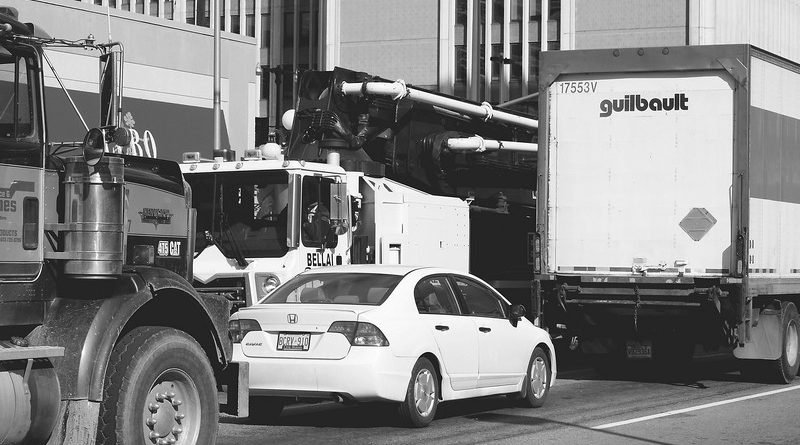Bridges, bulb-outs & bike lanes
Transportation issues in Sandy Hill overview
John Verbaas

The federal budget released last March contained an announcement that took many by surprise. It specifically brought up the topic of interprovincial transportation in the National Capital Region.
There were two parts to this announcement, the first federal word on crossings since the ill-fated, NCC-led, 2007-2013 Interprovincial Crossings Study. That was the study that suggested focusing on a new bridge at Aviation Parkway and Kettle Island. However, an abrupt withdrawal of provincial support brought that whole process to a swift end.
So what does a closer look at this budget announcement reveal? First, it undertook to provide funds to replace the existing, aging Alexandra Bridge and to provide additional funds for the ongoing maintenance needs of the Chaudière and Macdonald-Cartier Bridges.
Secondly, and of even greater interest to our neighbourhood, it committed to address—
. . . the demonstrated need for an additional National Capital Region crossing by refreshing existing studies and developing a long-term integrated interprovincial crossing plan led by the National Capital Commission with both provincial governments and the cities of Gatineau and Ottawa.
This phrasing seems to indicate an intention to move towards a new bridge, “crossing”, and by adding the phrase “refreshing existing studies” to imply there is a bias towards an Aviation Parkway Kettle Island bridge, as that is what the “existing studies” have been about. The phrase “developing a long-term integrated interprovincial crossing plan,” suggests there may also be an intention to bring to life a credible interprovincial transit plan, although the word ‘transit’ does not appear in the budget document.
Regarding working with the cities of Gatineau and Ottawa, the process did not get off to a great start, with both mayors interviewed in the media the next day, expressing little support for the creation of a new bridge focused on increasing capacity for cars. They suggested the focus should be on improved transit.
Downtown truck problem
 Meanwhile from a Sandy Hill perspective, one of the most important interprovincial transportation issues we face is the downtown truck problem. Each day 2,000 trucks, the majority tractor trailers, wind their way through Waller, Rideau, and King Edward, the main designated interprovincial truck route between the 417 and the Macdonald-Cartier Bridge. For 3 or 4 hours during the peak periods of the day, the volume of trucks is so high there is a truck passing by every 20 seconds.
Meanwhile from a Sandy Hill perspective, one of the most important interprovincial transportation issues we face is the downtown truck problem. Each day 2,000 trucks, the majority tractor trailers, wind their way through Waller, Rideau, and King Edward, the main designated interprovincial truck route between the 417 and the Macdonald-Cartier Bridge. For 3 or 4 hours during the peak periods of the day, the volume of trucks is so high there is a truck passing by every 20 seconds.
On this topic, the budget announcement was disappointingly weak. The only reference to trucks was an opening paragraph that made mention of the region experiencing “congestion due to truck traffic.” Well in fact, the extent to which interprovincial congestion is a problem is not due to the 2,000 trucks per day, but rather to the 75,000 cars per day that are using the Macdonald-Cartier Bridge. Secondly, this issue of 2,000 trucks per day winding through the downtown – causing unacceptable risks to life and negative impacts on the urban environment – doesn’t even get a mention. The continued existence of this now 52-year-old truck problem is a serious impediment to the development and renewal of Rideau Street and King Edward Avenue, and by implication to the communities of Lowertown and Sandy Hill, as well.
Looking ahead, we will need to work, together with the Lowertown community, to ensure any future study has, as one of its key objectives, finding an acceptable solution to this interprovincial downtown truck problem.
It’s a waiting game for now
There are some transportation-related changes brewing for Sandy Hill, but for now the theme is to wait patiently.
We are waiting to see how traffic is affected by the sewer and water infrastructure replacement coming soon – to sections of Templeton and Mann east of Chapel; to Range from Templeton to Somerset; and to Russell between Somerset and Osgoode. It is proposed that work will begin this year on Templeton and Russell; and on Mann and Range, in 2020.
Discussions have been ongoing over the past year regarding the traffic-calming measures to be built into the roads once they are reconstructed. Templeton will be narrowed slightly, and the parking arrangement reduced to only a single side of the street. There will also be “bulb-outs” (narrowings) implemented at the cross streets, as is currently the case on many other streets in Sandy Hill. The same kinds of changes will be implemented on Mann Avenue. Far fewer changes are currently planned for Range and Russell, although the community is still trying to convince the City that more can be done. Stay tuned – this story is still ongoing.
We are also waiting, patiently of course, for the LRT to start service: including the trial period, allowing the City to see all bugs are ironed out of the new system. Once that happens and the LRT-related bus detours are terminated, there will be some changes to Laurier Avenue and Waller Street.
Specifically, there will be significant changes to the Nicholas–Laurier and Waller–Laurier intersections to make them safer for cyclists. A separated bike lane will be added on Laurier between Waller and Nicholas, as well as on the section of Waller from Laurier towards the Mackenzie King Bridge.
Finally, some car movements that we have lost for the past four years will be restored, including the northbound right hand turn from Nicholas to Laurier and the 417 eastbound on-ramp at Lees. Unfortunately, the latter change is dependent on the provincial transportation ministry, so may not occur until later this fall, bundled together with other changes on 417 East related to unwinding the bus lanes.
We can expect to see more incremental traffic calming, funded from the $50,000 annual allocation per ward. For Sandy Hill, this will include more streets with SLOW painted on the pavement, a few more locations with flexible stakes added, and hopefully a couple of planter boxes installed on the longer blocks of Chapel: Chapel is one street that is not wide enough to accommodate flex stakes, as a traffic calming option.
There is progress, but it is slow and requires patience from all of us.
John Verbaas, a director of Action Sandy Hill, follows local transportation issues.
